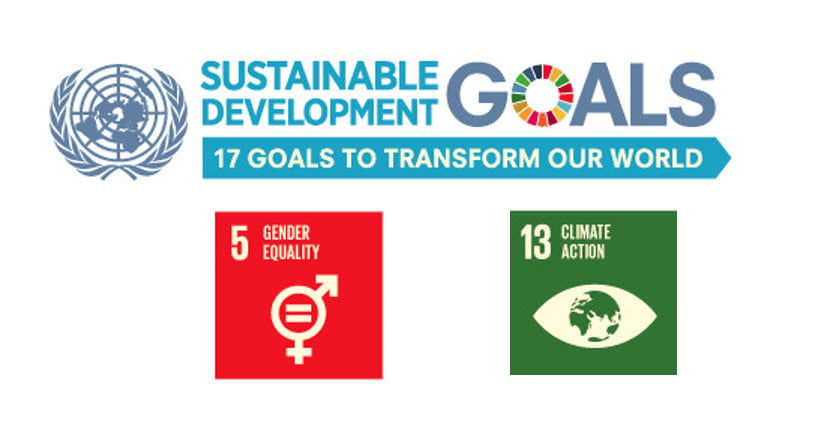In this resource we will explore the links between two of the Sustainable Development Goals – gender equality, and climate action.

Learning Objectives
- To be able to explain how Climate Change disproportionately affects women.
- To be able to give some examples of how women have a crucial role to play in adapting to or preventing climate change
According to the 2022 Intergovernmental Panel on Climate Change Report1
Climate resilient development is facilitated by developing partnerships with traditionally marginalised groups, including women, youth, Indigenous Peoples, local communities and ethnic minorities
IPCC 20221 SPM.D.2
Salinisation-associated changes may disproportionately burden women responsible for securing drinking water and fuel, such as in the Indian Sundarbans.
IPCC 20221, Section 3.5.5.3
Changes in water-related hazards disproportionately impact vulnerable populations such as the poor, women, children, Indigenous Peoples, and the elderly in all locations, especially in the Global South.
IPCC 20221, Chapter 4
Many countries and social groups most threatened by climate change have contributed the least to the problem and do not have the adequate resources to adapt. Water adaptation policies enabled through ethical co-production between holders of Indigenous Knowledge, local knowledge and technical knowledge; through cooperation and coordinated actions among multiple actors, including women and all marginalized groups, at various levels of governance is needed for effective transitions towards Climate Resilient Development.
IPCC 20221, Chapter 4
Climate-induced water scarcity and supply disruptions disproportionately impact women and girls. The necessity of water collection takes away time from income-generating activities, child care, and education.
IPCC 20221, section 4.3.3
Although women are often depicted as victims of climate change-induced water scarcity, they are also proactive adaptation actors
IPCC 20221 section 4.8.3
Optional activity – read out these statements and explore what phrases such as water-related hazards, climate resilient development, adaptation, salinisation, Indian Sundarbans etc. mean.
Optional Activity – watch these clips3 from the gender equality day at COP26.
Read this extract from the Malala Fund report2. The Malala Fund is working for a world where every girl can learn and lead.

Summarise the information in the extract in the following table:

The Malala Fund estimates that in 2021 climate-related events will prevent at least four million girls in low and lower-middle-income countries from completing their education. If current trends continue, by 2025 climate change will be a contributing factor in preventing at least 12.5 million girls from completing their education each year.
Complete this knowledge organiser using your existing knowledge of extreme weather and climate change :

The Mahila Housing Sewa Trust (MHT)’s mission is to organize and empower women in poor communities to improve their habitat.
A quality habitat is a home with all basic services such as clean water, toilets, electricity, and adequate light and ventilation. It is a key financial asset that supports livelihoods, and makes the poor more resilient to heat stress, disease, and other hazards of climate change. Women understand that a strong neighbourhood is essential to upgrading individual homes. They know how to work together to bring much needed services in their under-served communities.
Watch this video:
- In Indian slums, why are women more affected by climate change than men?
- Why are women better placed than men to lead climate change adaptation?
- What simple technology was the woman in the film using to cool her home?
Watch this video
- At the edge of the Sahara, what problem were women facing because of climate change?
- What did the women do, to solve the problem?
- What subsequent benefits has this had for them?
Watch this video
- For each of the three points made in the film, write a short paragraph explaining how women can make a difference to climate change.

Sources
- IPCC, 2022: Climate Change 2022: Impacts, Adaptation, and Vulnerability. Contribution of Working Group II to the Sixth Assessment Report of the Intergovernmental Panel on Climate Change [H.-O. Pörtner, D.C. Roberts, M. Tignor, E.S. Poloczanska, K. Mintenbeck, A. Alegría, M. Craig, S. Langsdorf, S. Löschke, V. Möller, A. Okem, B. Rama (eds.)]. Cambridge University Press. In Press. Sixth Assessment Report (ipcc.ch)
- A greener, fairer future: Why leaders need to invest in climate and girls education, March 2021, the Malala Fund
- COP26 recordings https://unfccc-cop26.streamworld.de/webcast/presidency-event-advancing-gender-equality-in-clim
